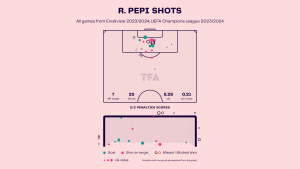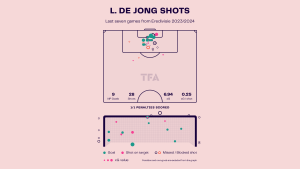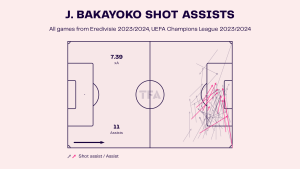This was a battle of two teams who are fighting against relegation. For both clubs, this games was important, one of those games that they can’t lose. A win would lengthen the gap between the other teams higher at the bottom of the table. With five matches unbeaten, VVV-Venlo have moved slowly away from the relegation zone. Two wins in a row with the support of the home crowd have given them a slightly favourable position going into this game.
Fortuna Sittard were looking for a first away win from the 21 games so far, in which they have lost 18 in Eredivisie. Also, they are two points above the last relegation place. With a win, they would have 27 points and be level with Venlo. This tactical analysis will be focusing on the tactics of both teams.
Line-ups
Hans de Koning lined up his team for this game in a 4-3-3 formation. They still missed a few players – former Premier League player Lee Cattermole was still injured along with Aaron Bastiaans and Peter van Ooijen. Former Liverpool player Jerome Sinclair was on the bench. At the same time, Fortuna’s head coach Sjors Ultee’s formation was the 4-4-1-1. There were not so many changes from the previous game. They had only one injured player which gave them a good start for this game. Djibril Dianessy missed out because of an injury.
Fortuna’s attack against Venlo’s low block
Fortuna had a lot of possession from the beginning of the game, mainly because Venlo dropped to a middle block or a low block defensive formation. Even with a huge amount of possession (60% in the first half), Fortuna were not able to create many good scoring chances. One reason for that was Venlo’s compact defensive shape.

Because of the opponents’ compactness, Fortuna’s central defenders Wessel Dammers and Branislav Ninaj were in playmaking roles during build-ups, mostly in their own third and around the halfway line. In many cases, there was no room for many advanced passes and Dammers often chose to dribble higher up the field. With these dribbles, they tried to open VVV’s formation.


As Fortuna tried to build up their attacks with short passes, those attacks came mainly from either the middle or from the right side. Two reasons why this attacking phase was powerless was the lack of movement from the attackers, and Venlo’s man-oriented defensive actions against Fortuna’s midfielders. Too many players moved to the ball, and not into space or into advanced positions.

At times when the build-up started in a more advanced position, Fortuna tended to do it from the right side. They often had a two-versus-two and in some cases a three-versus-three situation on the flank. From these situations, they manage to cross the ball a couple of times. Mainly because of the opponents’ good organisation, there was no room to score. Four of the five shots came from outside of the penalty area.
Another way that Fortuna tried to open Venlo’s organised defence was to play from the strong side to the open side where they created numerical superiority. Mainly this action started from Mark Diemers who played diagonal passes to the weak side. These situations ended normally with a bad pass or a poor individual action like a bad first touch.

While central defenders were able to dribble from deep into the opponent’s half, in those moments, especially on the right side, the focus was to play behind the opponent’s left-back. In these situations, right-back Lazaros Rota kept his width, as right-midfielder Felix Passlack created the option to play short by moving inside. Because of this move towards the ball, Diemers, from an attacking midfield position, could run from deep and in behind the defensive line.

VVV’s build-up
In this part of the analysis, we’re going to see how Venlo built their attacks. Venlo wanted to build up from the back and were able to do that because Fortuna dropped into a defensive mid-block. If there was a press, it was with one or two players pressing, more so as the opponent wanted to keep their shape in their own half. Most of the time, Venlo’s build-up happened from the right side. The central defenders and especially Nils Röseler had a key role in this phase. Once in the middle third, the midfielders’ participation were more actively to play forward.

When Venlo approached the halfway line, they were organised with numerical superiority in the middle and on the flank. In these situations, the player on the far side created a two-versus-one situation. The reason behind this was simple. If there was no option to attack with short passes, Röseler could play a long diagonal passes to the weak side to John Yeboah or Simon Janssen.

In the build-up phase, attacking players made runs from deep in behind the opponents’ defensive line, and if there was one-versus-one situation Röseler played a longer ball for the attackers. By attacking in different ways, Venlo forced Fortuna to drop deeper and restricted the space behind their line.

VVV’s problems in final third
VVV wanted to create a numerical superiority on the wings but were not able to do that if the attack was too slow. In slow attacks, Fortuna had enough time to get organised and advanced positioning was lost.

When Venlo reach the final third of the field, most of the times this would happen from the flanks, especially from the right side. They managed to play a lot into the areas from where they could pass or cross the ball into the box. The biggest problem in these situations was the players positioning in the box or around it. Too many players moved towards the goal and as a result the edge of the box was empty. On a couple of occasions, the cross was more like a cut-back pass but there were no players to receive that pass.

When Venlo did manage to create one-versus-one in areas where they could cross or even advance into the box, too many players were static, and only waiting for a pass to come. In these situations, they were forced to play against an organised defence, which made penetration more difficult.

There were moments when the opponent line was higher and there was space behind for a pass or move. Most of the time VVV lost those moments for two reasons. Firstly, the pass from the midfielder or defender to the winger came to the wrong side and the winger needed to take the first touch slowly. Because of this action, Fortuna could get organised or at least they could get a player close enough to delay the attack.

Because of this pass to the wrong side, the winger was forced to move to the corner instead of half-space or into the areas where he could get an early cross in. In these situations—even when they had enough players in a box—the crosses came from really wide and into the area where the defenders were well-organised.

Conclusion
This game was very defence-oriented as both teams didn’t want to lose. At the same time, both teams were tactically very organised and both teams had a real plan to win the game. But in football if you can’t create good scoring chances, you can’t win the game. This was the case today.
Fortuna started the game with some strong possession game, but they weren’t able to create any good finishing chances. Despite that, the way they played was promising. But at this point of the season, it is not enough. They need to find a way to create chances in the box and start to score goals. After this draw, their last win away from home was 23 games ago.
VVV showed good defensive organisation and played a very balanced game. While Fortuna did not manage to create any chances, Venlo did, but their finishing quality was very bad. Ultimately, this draw should help them to secure Eredivisie football for the next season. If they can find a balance between their defensive organisation and work on their attacking, they could reach a higher position in the league.










